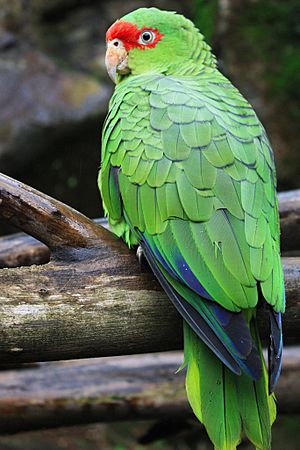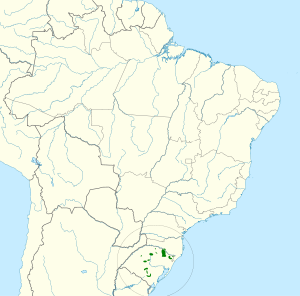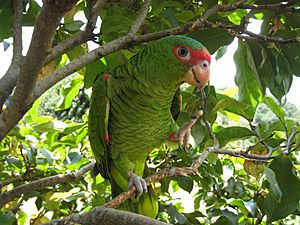Red-spectacled amazon facts for kids
Quick facts for kids Red-spectacled amazon |
|
|---|---|
 |
|
| In Brazil | |
| Conservation status | |
| Scientific classification | |
| Genus: |
Amazona
|
| Species: |
pretrei
|
 |
|
The Red-spectacled Amazon (Amazona pretrei) is a beautiful type of parrot found in South America. You can spot them in countries like Argentina, Brazil, and Paraguay. These parrots are known for their mostly green feathers with bright red markings around their eyes, which makes them look like they're wearing red glasses!
These parrots live in different kinds of places, including dry forests, moist lowland forests, and even forests on mountains. They also like open grassy areas called savannas and sometimes even plantations. Sadly, their homes are shrinking because of habitat loss.
Red-spectacled Amazons travel between different areas during the year. They fly from the northern part of Rio Grande do Sul in Brazil to the southeastern part of Santa Catarina. They do this to find and eat the seeds of the Brazilian pine, which grow in large amounts there.
These parrots are usually quiet and have a calm personality.
Contents
What Does the Red-spectacled Amazon Look Like?

The Red-spectacled Amazon parrot is about 32 cm (13 in) long. Most of its body is green. It has some red spots on its head, especially around its forehead, near its beak (lores), and around its eyes. This red coloring gives it its "spectacled" name.
It also has white rings around its eyes. The bend of its wings has red feathers, and the tips of its main flight feathers are blue. Its beak is yellowish. Female parrots usually have less red on the bend of their wings compared to males.
What Do They Eat?
In the wild, about 90 percent of the Red-spectacled Amazon's diet comes from the seeds of the Brazilian pine tree (also called Angustifolia seeds). Parrots that live in zoos or as pets eat a mix of vegetables and these same Araucaria seeds.
Why Are Red-spectacled Amazons in Danger?
The number of Red-spectacled Amazon parrots is going down. They are greatly threatened by two main things:
- Loss of their home: The forests where they live, especially the Araucaria moist forests, are being destroyed. This means they have fewer places to live and find food. In the past, these parrots lived in an area at least 10% larger than where they live now.
- Illegal pet trade: These parrots are very popular because of their colorful feathers, their ability to copy sounds, and because they are rare. Sadly, people illegally take eggs and young parrots from the wild to sell them as pets. It's estimated that nearly 500 young parrots are taken from their nests and sold in Brazilian cities every year. This illegal trade makes it harder for the wild population to grow.
See also
 In Spanish: Loro de anteojos rojos para niños
In Spanish: Loro de anteojos rojos para niños


